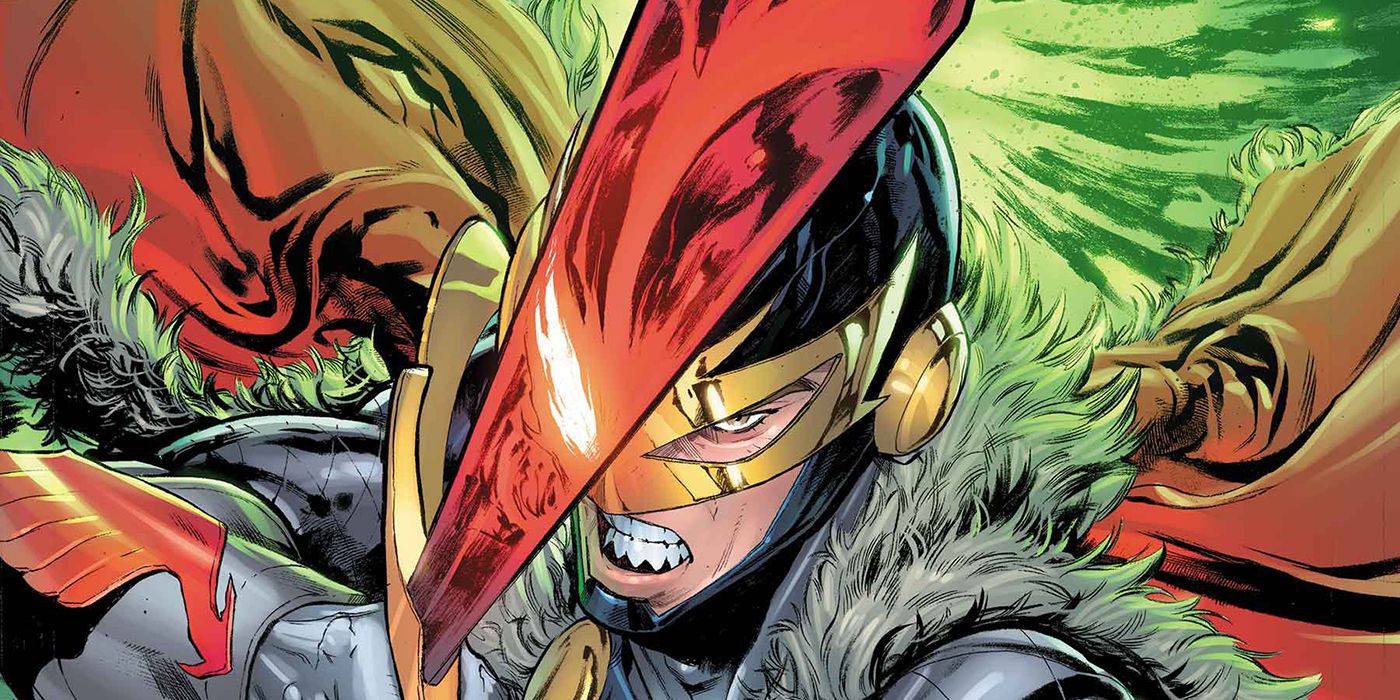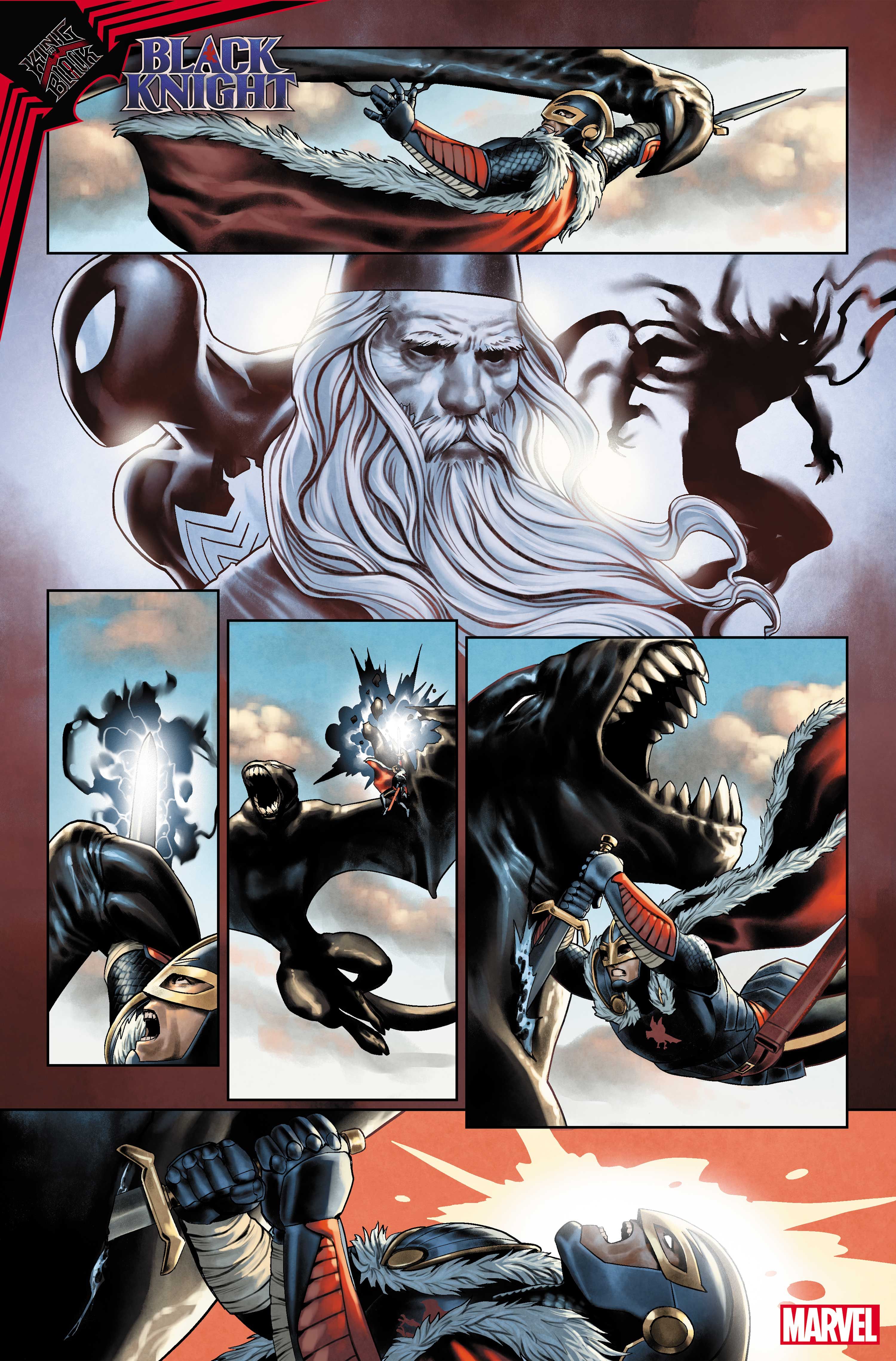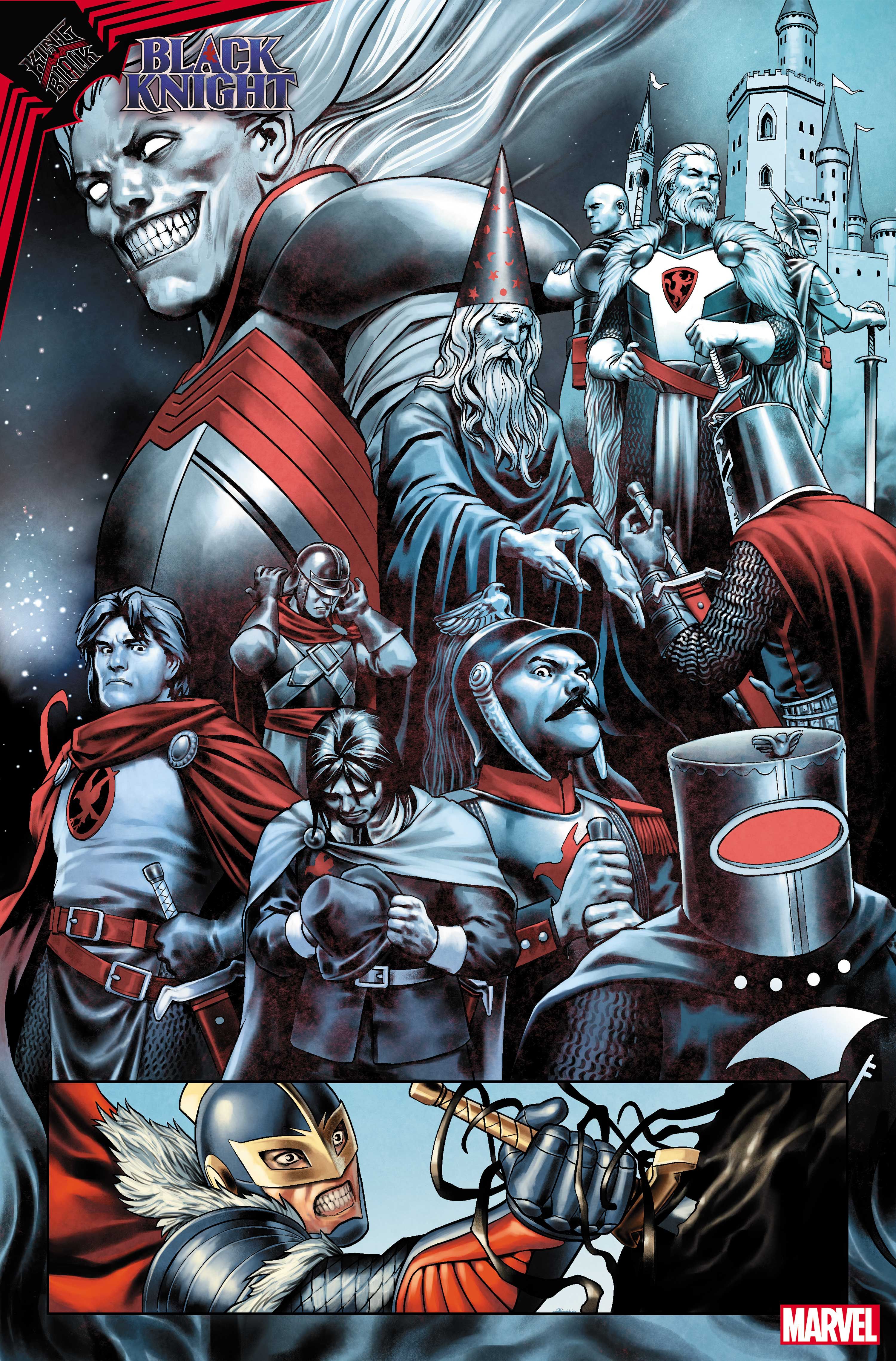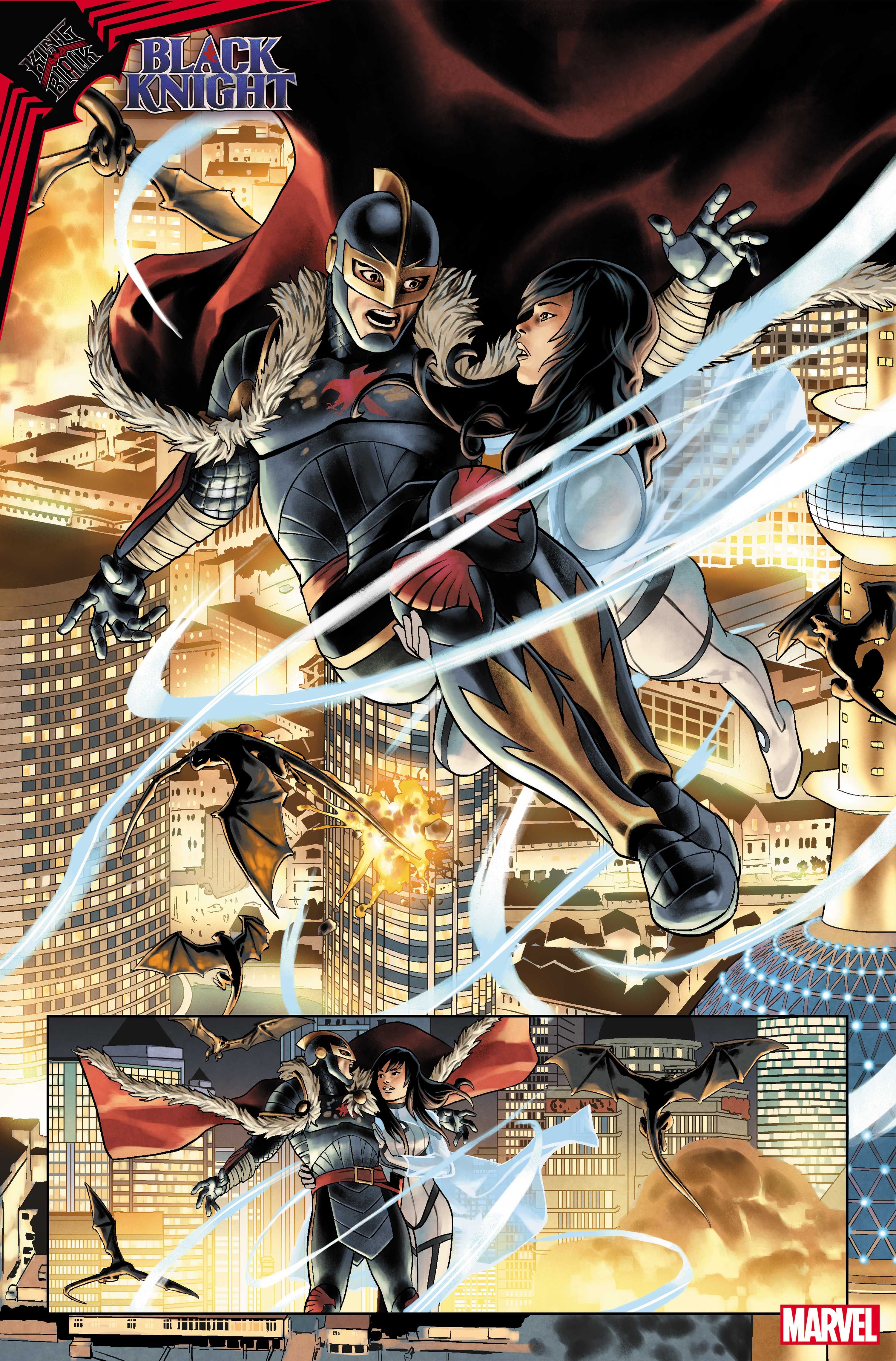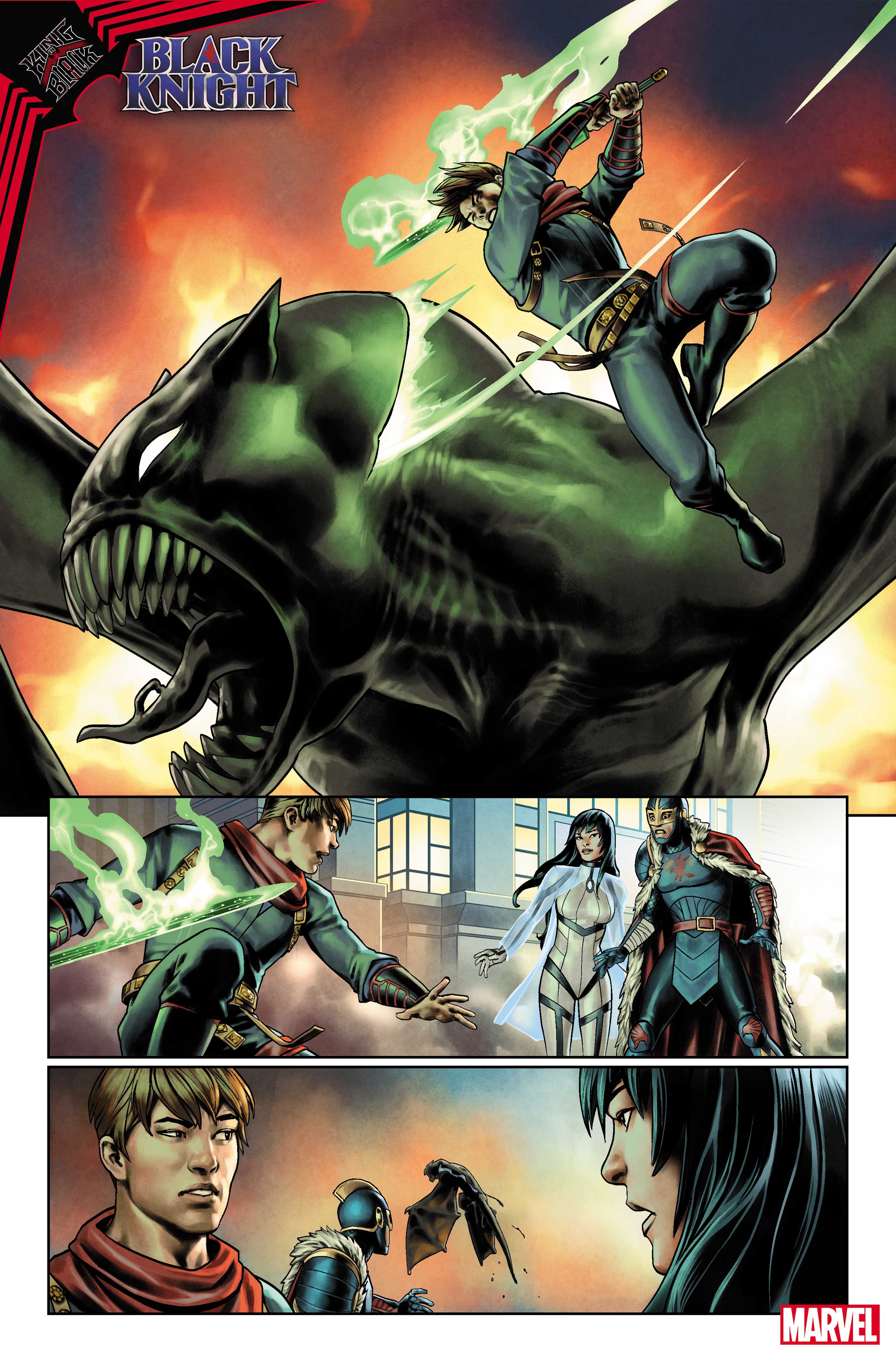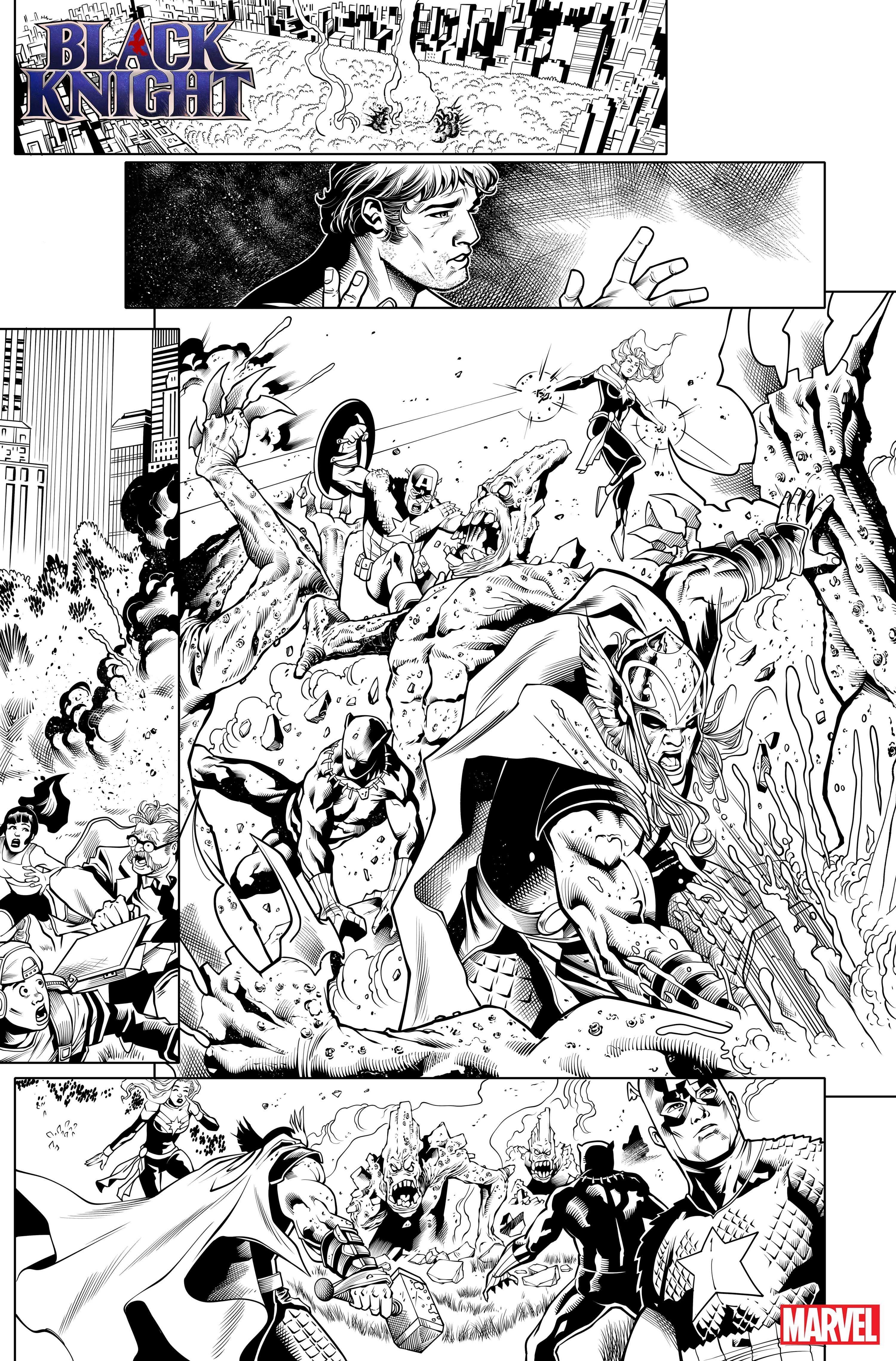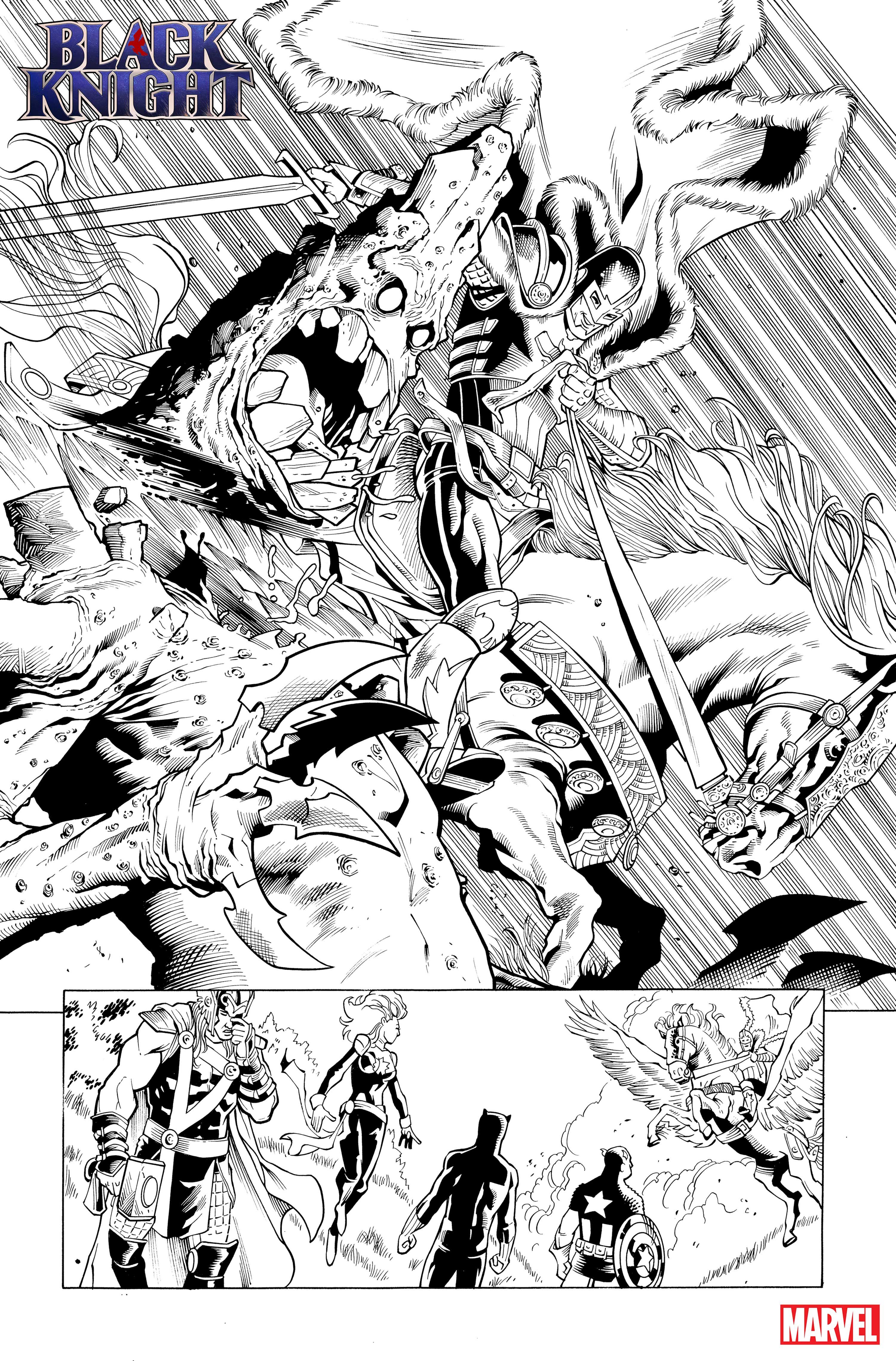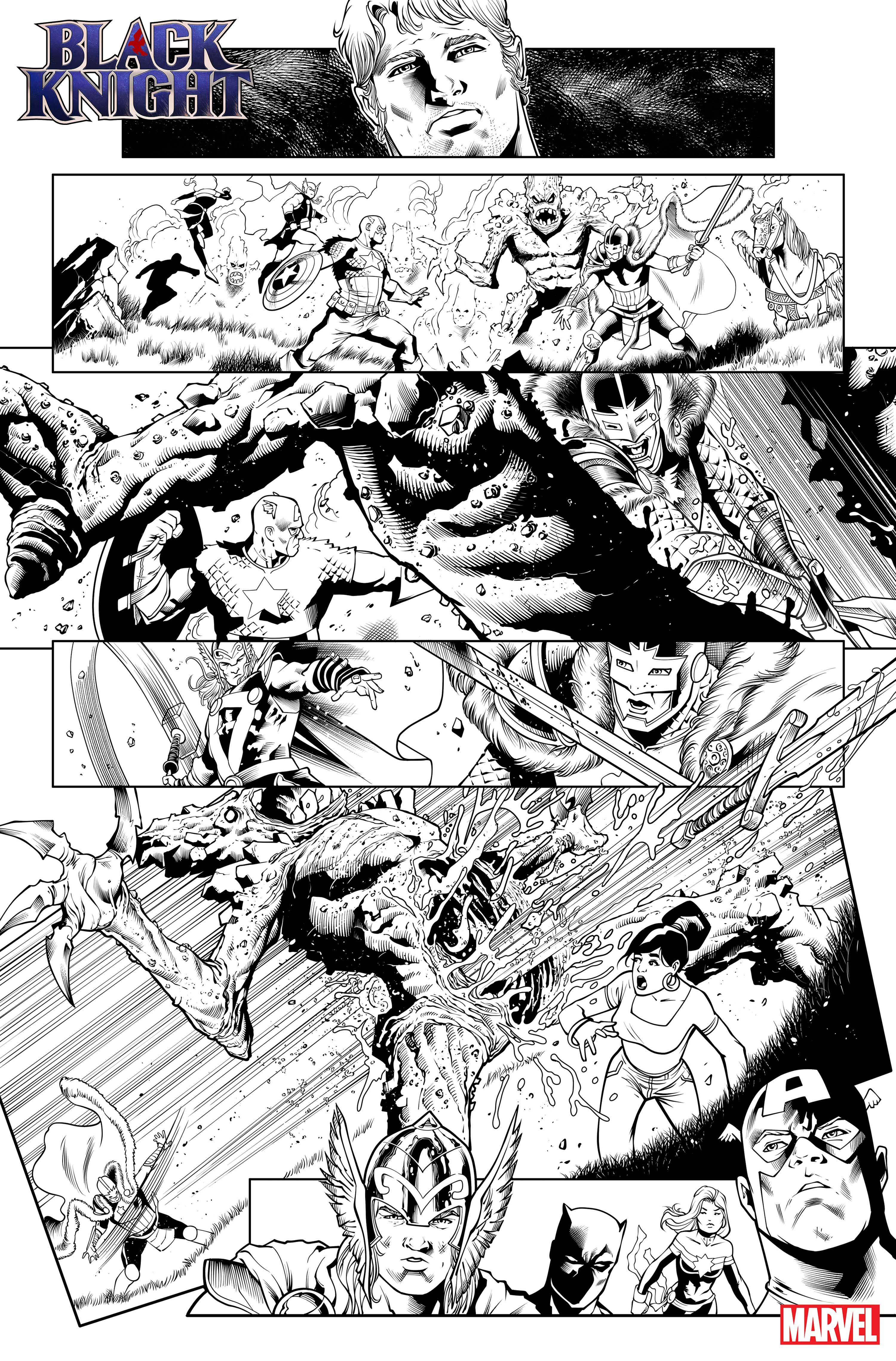The costumed swordsman known as the Black Knight (AKA Dane Whitman) is best known for two things; his cursed Ebony Blade and his membership in various Marvel Universe super teams like the Avengers, the Defenders, and Britain's MI-13. During his adventures with those teams and occasional solo exploits, a lot of backstory, some of it contradictory, accumulated about the Knight's sword, his lineage, and their connections to the fabled kingdom of Camelot. Those conflicting tales are about to be reinterpreted in a story that leads to a brand new era of solo action for Dane Whitman.
In the February one-shot, King in Black: Black Knight, writer Simon Spurrier and artist Jesús Saiz use the titular Marvel event as a backdrop for an adventure that redefines Dane Whitman's history and role in the Marvel Universe. Then, March's Black Knight ongoing series will see Spurrier and artist Sergio Dávila explore Whitman's new status quo with a history-spanning story involving blood magic and the true nature of King Arthur's court. CBR spoke with Spurrier about his plans for both Black Knight books, with a preview of the art in both books, including an exclusive look at Sergio Dávila's work from Black Knight #1.
CBR: Even though he's primarily appeared in team books the Black Knight is a character with a huge backstory. Does that make it easier or harder to write?
Simon Spurrier: The Black Knight, especially the Dane Whitman version, has gone through so many challenges and traumas as a character, but he's also been in the hands of so many different creators who've approached him from so many different directions. If you tried to pitch this character to someone who's never heard of him you're going to struggle. I tend to be drawn to those characters like a moth to a flame.
Here's a character who's only been defined by things like the team that he belongs to, the sword he carries around, or whoever he's been romancing at a particular time. To me, that speaks to a very interesting and probably very imperfect character. [Laughs] So, I want to know more about him. I want to learn what it is that makes him so keen to avoid being defined for his own right.
That's sort of the very beginnings of our one-shot. It wasn't at the forefront of my mind when I approached that book. I just wanted to tell a really cool story. The heart of our King in Black one-shot, for me though, is we found a really cool thing to introduce that simplifies and completely changes all the guff that surrounds that character's powers, history, motivations, and goals in a relatively simple elevator pitch-style way.
It has to do with his sword which has always been this needlessly complicated MacGuffin that has changed hands a billion times. Is it cursed? Or isn't it? Did it come from Camelot? Or Dracula? We're going to pay respect to everything that has come before, but we've found a way to condense and simplify things so we can say, “Here's this guy. He's a hero. He's really screwed up, and here's his thing. Go!” Hopefully, that's what we've done by the end of our King in Black one-shot; establish a slightly new take on the character that's respectful to everything that's gone on before. We had so much fun setting that up that when the option came along to use it to tell stories after this event we jumped at the opportunity.
Wielding the Ebony Blade has been part of what makes the Black Knight a classic Marvel hero in that his flaw, this cursed sword, is also his power.
Yeah, that's a lovely way to look at the character, and I have to circle around it as to not give anything away. The simplest way to do that is to use Thor as an example. Thor is super-strong and a lightning god, but if you get down to brass tacks he's a guy with a super powerful hammer. That artifact is sort of what defines him. It's his totem. And the wonderful thing about his hammer is it can only be wielded by someone who is Worthy. That tells you an awful lot about the character of the person who wields it. It has a relationship with the person who's wielding it, and to an extent, that's always been missing from the Black Knight.
He's always been this guy who comes from a lineage of people who've also been Black Knights. There have also been a few changes and retcons that made him a direct descendant of either King Arthur himself, or Arthur's nephew, or some other strange, hazy hierarchy that leads down from Camelot. He also carries around this great sword, but what was sort of missing and what we're leaning into is the thing that makes him powerful is not just the sword, but who he is in relation to the sword. We've honed in on that in a way that's quite unique, really dark, and a little bit twisted. It also makes Dane Whitman's desire to do good really difficult. So, he becomes this interesting hero in his own right because by doing the right thing he's making life harder and harder for himself.
I don't want the sword to feel like it's the important part of Dane Whitman's story. I want it to be a catalyst. I want it to be something that speaks to who Dane is and ultimately to the other characters around him who we meet and get to know. So, when we first meet him in the one-shot he's literally just lost the sword. There's a big fight with a dragon, and for reasons I can't get into, the most heroic thing he can do in that moment is let go of the sword. He falls out of the sky and is caught by a local hero in Shanghai.
That's where the adventure begins. For him, it's all about retrieving the sword because, as far as he knows, that's all he's got going for him. So, our story is all about twisting that and learning what else he has going for himself.
The heroes Dane encounters in the King in Black one-shot are Agents of Atlas members Aero and Sword Master. What's it like bouncing them off of the Black Knight?
Aero is really interesting in that she's very much a Chinese heroine who approaches superheroics in a Western way. She's all about protecting those who need protecting. She's loved by the people of Shanghai for that, and it all works quite nicely.
Sword Master is a slightly different character type in that his whole backstory relates to the loss of his father and a magical demon that's threatening to take over the world. So, his whole thing involves finding and destroying this demon to get back his father. He does good along the way, but he has a directed goal.
So, the interesting story in the one-shot for those two characters involves the responsibility to act within or outside their own personal motivations. Shanghai is under attack, and that speaks to a far bigger attack on the entire planet, which is the nature of the King in Black event. Aero doesn't think twice. She's clearly here to help. Sword Master does think twice because this isn't the demon he's looking to fight. He's a ridiculously superpowered kid with an incredible sword, but it isn't any of his business. As soon as he's established that he thinks he should get out of the way. Then stuff happens between him and Dane Whitman that involves the fact that they are two men who, up to now, have been defined by their crazy, powerful swords.
There's a lot of culturally interesting and funny stuff that goes on between these two guys; one who is looking for his sword and another who is being judged by his sword for choosing not to intervene in a crisis.
On top of that, you've got cosmic horror and dragons. So it feels fitting you have an artist who can deliver all that in Jesús Saiz.
He's an absolutely remarkable artist. Every day, we look forward to receiving his pages in our inboxes. It's just mind-blowing stuff. For somebody who paints such detailed and stunning fantasies, A) he's super- fast and B) the storytelling and acting is absolutely spot on. You'd expect one of those things to be left behind in the process of delivering these glorious pages, but, no, he's the total package.
Does the King in Black one-shot serve as a springboard to March's Black Knight series?
The one-shot is where we boil down who the Black Knight is and what his thing is. Then the purpose of the series is to lean into, interrogate, and run with that. Along the way, we'll encounter a couple of other big twists that have to do with expanding and exploring the lore that plays in the background of the character, especially the aspects having to do with far back and ancient history.
What's the inciting incident that kicks off the ongoing series?
It opens with the Avengers in Central Park battling these giants who seem to be made of solidified blood. Every time they smash one of these things it just reforms and slithers back up, right again. So, they're struggling and they do what an awful lot of heroes would do; call in the nuke. They're like, “We're the Avengers. We could probably defeat these guys, but it would take us all day and could cause some collateral damage and fatalities. So let's call in the WMD.”
At the beginning of our series, when you have to call in the WMD, it's the Black Knight. He rides in on his flying horse into the middle of the park and does what he does. I don't want to go into too much detail and spoil things, but the drama comes from the fact that Dane Whitman has been an Avenger. He's hung out with them, and secretly feels that he should still be a central part of the team. He thinks, “I led this team at one point and now they only call when they want me to take down certain threats?” That's depressing. It makes you question who you are, who your friends are, and what your value is.
One of the really twisted realities of this new take we have on his relationship with his magical weaponry is that the more depressed he becomes, the more useful he is as a hero. That's a rotten self-perpetuating cycle that means the darker he becomes, the more mighty a warrior he is. [Laughs] It's a horrible fate to be stuck in. That's where our story begins and quite quickly, the thing that happened in Central Park sets up a whole lot of shenanigans that take place all over the world that have to do with blood magic and finding other long-lost scions of the same descent and lineage.
One of the big missions that we embarked on in this series is examining Camelot and the Arthurian cycle through the filter of the Marvel Universe. We've all heard versions of these stories from the Vulgate Cycle, Malory, and others. Those Arthurian myths don't make sense though in any historical way. They just can't have been real. They contradict each other and they don't take place in any recognizable locale.
Our vision of steel armored knights romping around, and participating in jousting tournaments is like a 12th century Norman creation. If there was anything like a Camelot, a Round Table, or a unified kingdom during the centuries this supposedly happened, which is allegedly between the sixth and the ninth, it would have been Saxon warriors, mottes and baileys, and wooden towers. Nothing like we picture.
So, my editor said to me, “Wouldn't it be cool if Camelot was like the Manhattan of the modern day Marvel Universe?” It's a place teeming with extraordinary heroes and villains. So, if you can twist that and view it through a quasi-historical lens than it all starts to make sense. Plus, we have some really cool stuff explaining why Camelot doesn't make sense historically and why it disappeared from the archeological record in a way that directly relates to who Dane Whitman is and the Black Knight's role in the modern, and really any, world.
That's a hint of our plans for the ongoing. It's a personal story about one man grasping with his sense of belonging and learning a lot about himself and who he's supposed to be in the process. Plus, we have the broader canvas of leaning into an examination of all these cool, historical things and the broader stuff that has come from the past and into the modern Marvel Universe. So, we're injecting a lot of rich magic into this character's background in such a way that makes it all makes sense. And if I do my job right we'll explain why Dane's past was so contradictory and complicated while giving everybody the excuse to set that aside and say, “Here's why it was that way.”
This is a series that looks at the collision of fantasy and modern-day superheroics. So, Sergio Dávila, who's coming off a run on DC's Wonder Woman, seems like a great person to handle the art.
He's perfect for this book and he's got endless love for the source material. Every time we let him draw anything remotely fantastical he's hopping down in delight. I don't know if I've ever seen an artist so happy over what he's being asked to draw. [Laughs] One of his favorite characters is Thor. So, there's some Thor action that he really enjoyed.
He does amazing action sequences, has a wonderful take on horror-centric blood magic, and is great at combining the historical aesthetic with the modern world. Plus, he's amazing at all the quiet moments of characters acting and sitting in darkness feeling sorry for themselves. This book is very much my speed and very much Sergio's as well. We seemed to be very well matched.

